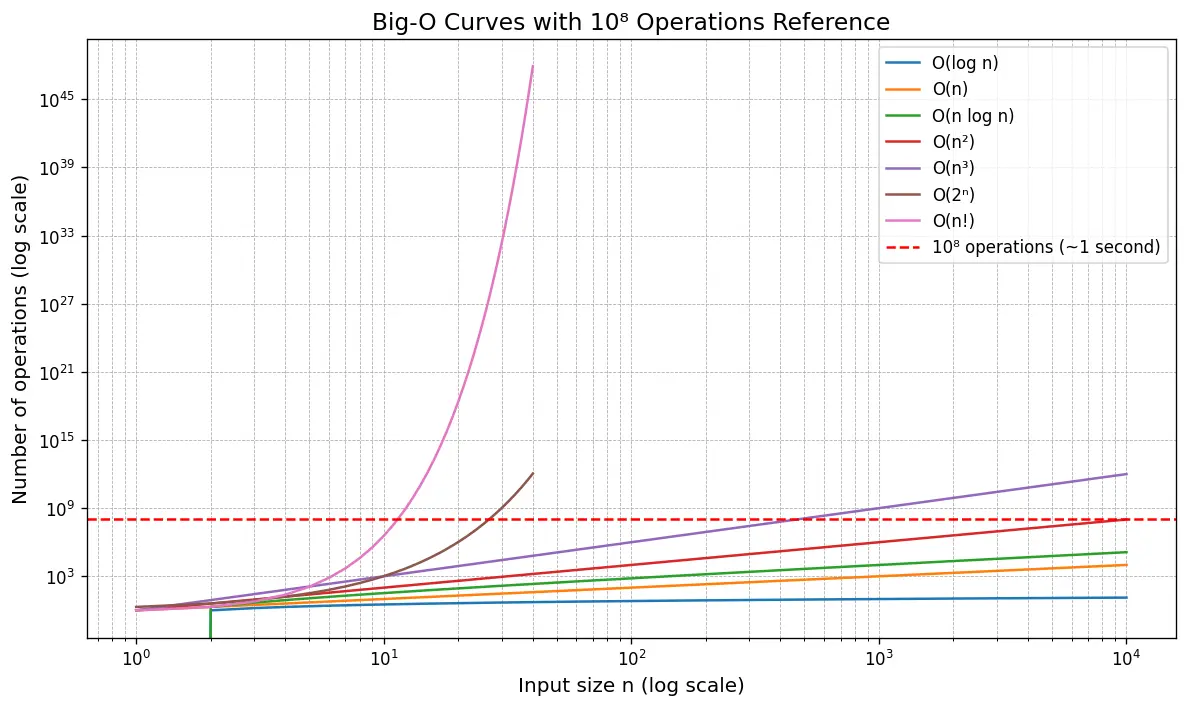Big-O 複雜度評估
大O符號用來衡量一個演算法,對於能直接影響執行次數的輸入值n評估且忽略所有常數項,評估執行的時間和占用記憶體的效率
 常見的量級有上圖這些,解題的時間要求標準是1秒,大約在10的8次方
常見的量級有上圖這些,解題的時間要求標準是1秒,大約在10的8次方
比如輸入值n的上限是10^8的話通常會有O(n)或更優的解,使用O(n²)的話會超時
Big-O在實務上理解代碼就能大致知道在哪一個量級,特定的演算法在網路上可查詢,本篇不做數學式的說明。
常數時間,輸入內容不影響程式執行步數
O(log n)
Section titled “O(log n)”log在這裡一般默認以2為底,常見的二分搜尋就是O(log n)
針對已排序的資料每次找中間點的方式來找內容
說明:
例如從 1~100 找一個數字:
- 第一次找 50
- 如果目標 > 50 → 在 51~100 中間找 75
- 如果目標 > 75 → 在 76~100 中間找 87
- 重複以上過程直到找到目標
範例:
一個已排序的陣列 arr 判斷是否存在內容 item
#include <iostream>#include <algorithm>#include <vector>using namespace std;
// 手寫版 - 可自行練習bool BinarySearch(const vector<int>& arr, int item) { int left = 0; int right = arr.size() - 1;
while (left <= right) { int mid = left + (right - left) / 2; if (arr[mid] == item) { return true; } else if (arr[mid] < item) { left = mid + 1; } else { right = mid - 1; } } return false;}
int main(){ vector<int> arr{ 1, 2, 3, 4, 5 }; int item = 3; cout << (binary_search(arr.begin(), arr.end(), item) ? "True" : "False");}namespace ConsoleApp1{ internal class Program { // 手寫版 - 可自行練習 static bool BinarySearch(int[] arr, int item) { int left = 0; int right = arr.Length - 1;
while (left <= right) { int mid = left + (right - left) / 2; if (arr[mid] == item) { return true; } else if (arr[mid] < item) { left = mid + 1; } else { right = mid - 1; } } return false; }
static void Main(string[] args) { int[] arr = [1, 2, 3, 4, 5]; int item = 3; Console.WriteLine(Array.BinarySearch(arr, item) >= 0); } }}常見的有線性搜尋和任何將內容循環一遍的敘述
對於未排序資料,從頭到尾搜尋陣列內容
說明:
例如從1~100找一個數字,從1開始,逐一檢查每個數字,直到找到目標或結束
範例:
在未排序陣列 arr 中找到元素 item 的索引,若不存在則返回 -1
#include <iostream>#include <algorithm>#include <vector>using namespace std;
int main(){ vector<int> arr{ 12, 43, 56, 78, 9 }; int item = 9; auto it = find(arr.begin(), arr.end(), item); if (it == arr.end()) { cout << -1; return 0; } cout << distance(arr.begin(), it); return 0;}namespace ConsoleApp1{ internal class Program { static void Main(string[] args) { int[] arr = [12, 43, 56, 78, 9]; int item = 9; Console.WriteLine(Array.IndexOf(arr, item)); } }}arr = [12, 43, 56, 78, 9]item = 9try: print(arr.index(item))except ValueError: print(-1)O(n log n)
Section titled “O(n log n)”基本的快速排序法的平均複雜度,不過快速排序在極端情況比如資料已經排序好的時候最壞情況是O(n²)
快速排序法是一種當前常見的排序演算法
說明:
- 選擇一個基準值(pivot)
- 所有比pivot小的放在它前面,比pivot大的放在後面
- 分別對pivot的左右兩邊重複上述動作,直到子陣列長度<=1
範例:
使用c++的內建的快速排序法,將陣列 arr 遞增排序
#include <iostream>#include <algorithm>#include <functional>using namespace std;
int main(){ // qsort是c函數,比較函數的參數型別較複雜,c++可直接用sort()做非指定排序 int arr[] = { 5, 2, 9, 1, 5, 6 }; qsort(arr, sizeof(arr) / sizeof(arr[0]), sizeof(int), [](const void* a, const void* b) {return *(int*)a - *(int*)b; }); return 0;}常見的有泡沫排序法,但是兩層for循環n就是最明顯的n²樣式
泡沫排序法是一種較慢的排序法,適合學習用途
說明:
- 循序讀取陣列一遍,將兩兩相鄰內容比較
- 如果前面大於後面,則交換它們 (遞增)
- 重複以上內容直到沒交換過
範例:
使用泡沫排序法將長度為 n 的陣列 arr 遞增排序
#include <iostream>using namespace std;
int main(){ int arr[] = { 5, 2, 9, 1, 5, 6 }; int n = sizeof(arr) / sizeof(arr[0]); bool swap = true; while (swap) { swap = false; for (int i = 1; i < n; i++) { if (arr[i - 1] > arr[i]) { int temp = arr[i]; arr[i] = arr[i - 1]; arr[i - 1] = temp; swap = true; } } } return 0;}namespace ConsoleApp1{ internal class Program { static void Main(string[] args) { int[] arr = [5, 2, 9, 1, 5, 6]; int n = arr.Length; bool swap = true; while (swap) { swap = false; for (int i = 1; i < n; i++) { if (arr[i - 1] > arr[i]) { int temp = arr[i]; arr[i] = arr[i - 1]; arr[i - 1] = temp; swap = true; } } } } }}主要有矩陣乘法以及三層迴圈n的東西,比如佛洛依德演算法
Floyd-Warshall演算法
Section titled “Floyd-Warshall演算法”佛洛依德演算法用於取得任意兩點間的最短路徑
說明:
涉及後面會提到的圖論,這邊只說明關鍵內容
如果 i 到 j 的距離比 i 到 k,k 再到 j 的距離還大,則將 i 到 j 的距離更新成 i 到 k 到 j
範例:
Floyd-Warshall的核心代碼
for(int i = 0; i < n; i++) { for(int j = 0; j < n; j++) { for(int k = 0; k < n; k++){ if (dist[i][j] > dist[i][k] + dist[k][j]) { dist[i][j] = dist[i][k] + dist[k][j]; } } }}全排列以及一些暴力解
說明:
將陣列的內容按順序將全部可能的排列方式輸出
範例:
使用python的itertools的排列函數permutations生成
import itertools
arr = [1, 2, 3]print(*itertools.permutations(arr))/*(1, 2, 3) (1, 3, 2) (2, 1, 3) (2, 3, 1) (3, 1, 2) (3, 2, 1)*/空間複雜度較簡單,將數據大小乘以使用數量就是實際用量,比如 n = 1024 建立一個 int arr[n] 就是用了4 bytes × 1024 = 4096 bytes
在編寫代碼時一般會將使用的陣列大小宣告好,可以明確的看出記憶體用量。